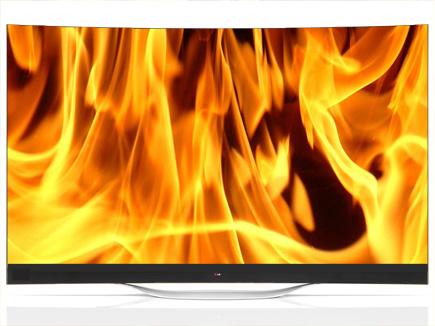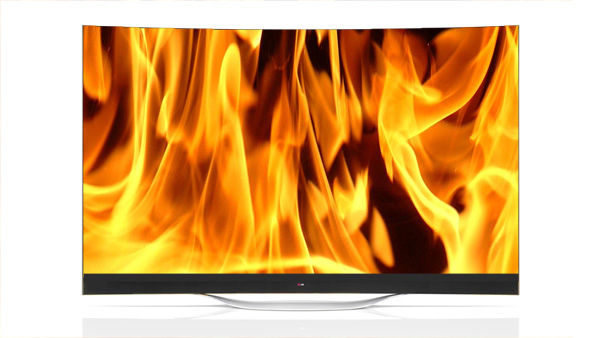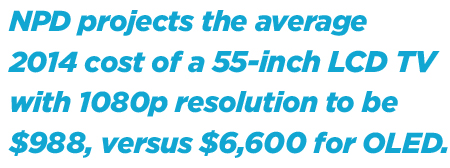Are OLED TVs Doomed?
Despite hype from TV makers, the always-around-the-corner screen tech may never catch up to LCD, especially in price.


Superthin, super-colorful OLED TVs were front and center at the Consumer Electronics Show in in 2013. But they faded into the background at the latest CES, yielding to a new breed of LCDs that accomplish what previously only OLED screens could: they curve.
Organic light-emitting diode technology results in screens that are amazingly thin (as they don't require the backlight that LCDs do) and amazingly colorful due to the saturated hues the chemicals produce when hit with electricity. Small OLEDs have been appearing on smartphones and other mobile devices for years. But the always-dreamed-of OLED devices – giant screen TVs – may never come to pass in a meaningful way, new research shows.
MORE: 10 Hottest TVs for 2014
It's not that the technology doesn't work. Big OLED backers LG and Samsung are already selling – for a fortune - curved 55-inch TVs that deliver the brilliant pictures that OLED has long promised. Prices are six to seven times higher than for comparable LCD TVs because the screens are very difficult and expensive to make.
In fact, a majority of OLED screens coming off the assembly line have to be thrown out because of defects, according to analyst firm DisplaySearch (a division of NPD). Unless production of OLED screens gets much more efficient quickly, they may lose the fight to good old LCD technology, which continues to get not only lower in price but higher in quality.
"The next big premium TV is not going to be an OLED," said Paul Gagnon, director of TV research at DisplaySearch. He expects 4K (aka Ultra HD) sets to take that role instead. And the data in his Quarterly Global TV Shipment and Forecast Report (last published in March) back up that claim. For 2014, Gagnon projects the average global cost of a 55-inch LCD TV with 1080p resolution to be $988. He expects an OLED TV of the same size and resolution to cost $6,600.

Meanwhile, 55-inch 4K TVs (with four times the resolution of HDTV) using LCD tech could average out to just $1,300, though that's partly due to ultra- cheap models being made in China. Still, even 4K TVs sold in the U.S. will be much cheaper than OLEDs. Premium TV maker Samsung's 55-inch 4K models start at $3,000, for example, and that will drop under pressure from Chinese manufacturers. "Prices are going to come crashing down soon enough," Gagnon told Tom's Guide.
Sign up to get the BEST of Tom's Guide direct to your inbox.
Get instant access to breaking news, the hottest reviews, great deals and helpful tips.
Whether or not 4K goes big time, the price difference between OLED and LCD models of HDTVs will make LCD a no-brainer purchase for most consumers. And they may not be giving so much up.
"LCD is a moving target," Gagnon said. "Every time it looks like OLED is ready to be mass produced, LCD moves ahead in price and performance." The jump to 4K is one example, as Gagnon is skeptical that LG and Samsung will be able to mass produce 4K OLEDs anytime soon.
MORE: What is 4K TV?
Another example of LCD moving ahead is curved screens. This has long been the purview of OLED, as seen in the new Samsung Gear Fit smartwatch. And the first OLED TVs, from LG and Samsung, were all slightly curved models. But CES was awash in curved LCDs. And Samsung made a huge show of the tech at a media spectacular in New York City's famously curvaceous Guggenheim Museum. Nearly every TV on show in the rotunda (both 4K and HD) was a curved LCD, and there wasn't an OLED to be found.
"That's … exactly what I mean — that LCD can keep pace with OLED," Gagnon said.
Whether or not a curved LCD is a worthwhile investment for videophiles, it's a lot cheaper than OLED. Samsung's 55-inch curved LCD, in HD resolution, lists for $2,500. Its comparable OLED set sells for $9,000.
Gagnon and DisplaySearch are not ready to proclaim OLED dead just yet, as they are still waiting to see if Samsung and LG can throw enough money at the technology to make it viable. But the prospect of a flop is real, said Gagnon: "Yes, there is a chance that OLED will fail to make it."
Follow Sean Captain @seancaptain and on Google+. Follow us @tomsguide, on Facebook and on Google+.
Sean Captain is a freelance technology and science writer, editor and photographer. At Tom's Guide, he has reviewed cameras, including most of Sony's Alpha A6000-series mirrorless cameras, as well as other photography-related content. He has also written for Fast Company, The New York Times, The Wall Street Journal, and Wired.
-
toddybody Price is definitely the greatest issue to adopting OLED displays (both for televisions and monitors). That said, I havent heard of any other technology to come close to OLED's contrast capabilities...and IMO, that is going to keep manufacturers motivation to drive cost down to attainable points for consumers. Would I spend 500% more on an OLED panel than a plasma (RIP) right now? Absolutely not. Would I spend up to 50% more for an OLED over a leading LED? Most likely.Reply -
td854 I think one problem is that a 55 inch TV doesn't need to be curved, maybe an 80 inch, but not 55. They're just taking an unnecessary step there in manufacturing that's creating more expense.Reply
I don't know how more recent models compare but I've had a 55" 7000 series samsung led/lcd tv and it's beautiful in lighted scenes but the moment the scene gets dark; backlight bleed on the edges. This is the main reason i would want to switch to an OLED, for the dark scenes, nothing else compares. -
mauller07 OLED is a pinnacle of surface based display technology being an emission display with each pixel self illuminating allowing the very large contrast and massive colour gamut that cannot be rivaled by LCD's. a mixture of the contrast and large colour gamut is the main reason for the displays appearing so saturated since we simply are used to displays that have faded colours and very poor contrast in comparison.Reply
Production techniques will only improve, this is no different to when LCD's first were released and a 50in LCD would set you back for the price of a super car (around 150,000) when they appeared, OLED is comparatively far cheaper for the pure quality of the display.
i think LG's technique of using pure white OLED substrate with a colour filter in front is the most production efficient currently as only one chemical is required in the process. -
Au_equus Just due to their chemical nature, OLEDs are a whole lot less stable than their metal/metal oxide LED counterparts. Have they figured out a way around blue OLEDs from degrading faster than reds and yellows? IMO, since we keep TVs around a lot longer than our cellphones, OLED should just be restricted to "disposable" electronicsReply -
icemunk ReplyJust due to their chemical nature, OLEDs are a whole lot less stable than their metal/metal oxide LED counterparts. Have they figured out a way around blue OLEDs from degrading faster than reds and yellows? IMO, since we keep TVs around a lot longer than our cellphones, OLED should just be restricted to "disposable" electronics
They've came a long ways since the first generation. Blue OLED diodes in the newer generations achieves 62,000 hours of usage rating (compared to 198,000 hours for the green) - none the less, that is 7 years of 25/7 usage. -
Menigmand It's so bizarre how they keep pushing curved displays. Who asked for those? What I personally want is better image quality.Reply
4K is another strange tech driver... -
velocityg4 The big selling point of flat screens is that they don't distort the image. Why would I want to go back to something I got rid of in the 90's? As for OLED I thought the advantages over LCD was lower power usage and a richer color gamut.Reply -
Be0wulf22 My next TV will be 4k and OLED....and I don't care how long I have to wait for it. I'm not upgrading again until I get it.Reply -
jasonelmore OLED is not dead unless they can find a way to make LCD Colors as good as OLED. Sure flexibility is cool, but it's the colors, the deep blacks, the blinding whites, that make OLED amazing.Reply -
xenol What I don't understand is why did they have to go to other size extreme at 55"? Why not release smaller sized TVs? Or heck, why not release OLED computer monitors?Reply
Why does OLED have to be either in 5" smartphones or 55" TVs?
